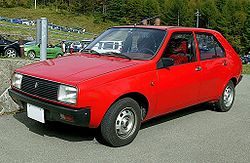Renault 14
| Renault 14[1] | |
|---|---|
 | |
| Overview | |
| Manufacturer | Renault |
| Production | 1976-1983 |
| Assembly | Douai, France Haren, Belgium |
| Body and chassis | |
| Class | Small family car |
| Body style | 4-door hatchback |
| Layout | FF layout |
| Powertrain | |
| Engine | 1.2 L I4, 59 PS (43 kW; 58 hp) 1.4 L I4, 60 PS (44 kW; 59 hp) or 70 PS (51 kW; 69 hp) |
| Dimensions | |
| Wheelbase | 2,530 mm (100 in)/ 2,560 mm (101 in) |
| Length | 4,025 mm (158.5 in) |
| Width | 1,624 mm (63.9 in) |
| Height | 1,405 mm (55.3 in) |
| Curb weight | 855 kg (1,885 lb)-890 kg (1,962 lb) |
| Chronology | |
| Predecessor | Renault 6 |
| Successor | Renault 9/11 |
The Renault 14 is a small family car produced by the French manufacturer Renault between 1976 and 1983.
History
Featuring front wheel drive, the 14 was developed as a competitor in the small family car segment, which had been opened up by the Volkswagen Golf. Initially, the 14 was available in L and TL trim levels with a 1.2 L single overhead camshaft engine sourced from Peugeot; later 1.4 L versions with 60 PS (44 kW; 59 hp) (R14 GTL) or 70 PS (51 kW; 69 hp) (R14 TS) joined the line-up. The design was generally well thought out and practical with interior space a major selling point, including a rear seat that could either be folded or removed completely. In addition, the spare wheel was carried at the front, under the bonnet and above the transverse 4-cylinder engine that was inclined backwards by 72°. Although all Renault cars were by now front wheel drive, the 14 was the first of the manufacturer's models to incorporate a space saving Mini-like transversely mounted engine.[3] The exterior styling of the Renault 14 was praised by the motoring press as being fresh and ahead of its time.

The 14 shared with several previous Renault models a rear suspension system using two full-width torsion bars positioned one behind the other, along with the resulting wheelbase difference of more than 1 inch (32 mm) between the left and right sides of the car.[3]
"The Pear"
Things got off to a bad start with a disastrous advertising campaign that compared the 14 to the shape of a pear. A preview at Paris' Pompidou Centre as a bare bodyshell did little to win it customers. The car would later gain a reputation for premature body corrosion which saw the 14 being dubbed as the "rotten pear" by the motoring press. In France, "La poire"' (literally "the pear", but also slang for "gullible") still refers to the 14. However, the best-selling Renault 5 also had a reputation for premature body corrosion, but the stronger and more adequate advertising of the R5 helped boost its sales and resulted in it being a sales hit.
The car also had a reputation for being difficult to start in damp conditions. The placement of the temperature gauge on the transmission tunnel behind the gear-lever, rather than on the instrument panel where it was directly in the driver's field of view, led to incidents of engine damage if the engine overheated and the driver failed to notice.
Relaunch
Renault later attempted to enhance the car's appeal by relaunching it with improved equipment levels, but the damage was done and the production run ended in 1983 with around one million units sold over a period of just under seven years. The 14 is now a rare sight on the roads of Europe, even in its home country of France where they have tended to last longer than elsewhere due mainly to easy parts availability through the extensive dealer network. Many Renault 14 were used by the French police in the 1980s.
Its joint successors, the 9 and 11 appeared in 1982 and early 1983, respectively. The front end of the pre-facelift Renault 9 looked similar to the front end of the post-facelift Renault 14. However, both the Renault 9 and 11 had more conservative exterior body styling.
Timeline
- 1976 - The Renault 14 was launched in L and TL trim levels, both of which came with a 1.2 litre Peugeot engine.
- 1979 - The higher-specification R14 TS was added to the lineup but still with unchanged mechanical specification.
- 1979 - Model name changes: the R14 L became the R14, while the R14 TL became the R14 GTL.
- 1980 - The R14 TS gained a larger 1.4 litre engine.
- 1980 - The R14 LS was added, featuring the 1.4 litre engine from the TS but a more basic equipment specification like the R14.
- 1982 - The R14 GTL got a lower-powered economy-tune version of the 1.4 litre engine from the LS and TS.
- 1983 - Production of the R14 ended; the car was replaced by the Renault 9/11.
References
- ^ Data according to: Automobil Revue, catalogue edition 1979, p. 470-71.
- ^ "Autotest: Renault 14. Addition to Renault range, very roomy in relation to compact exterior dimensions. Excellent seats and ride, versatile loading arrangements with rear door. Good steering and handling. Moderate performance but reasonable economy. Competitive price for what it offers". Autocar. 146 (nbr 4194): pages 24–29. date 26 March 1977.
{{cite journal}}:|pages=has extra text (help); Check date values in:|date=(help) - ^ a b "Midi-Renault". The Motor (magazine): pages 24–26. 29 May 1976.
{{cite journal}}:|pages=has extra text (help)
